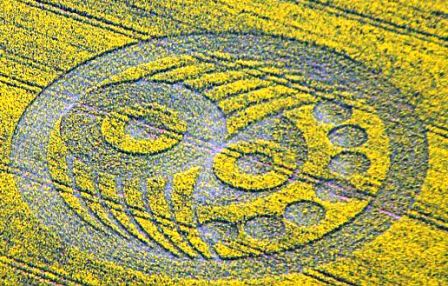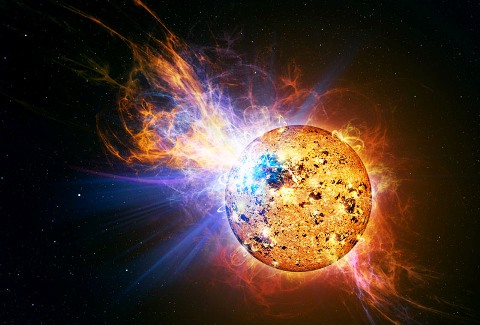"Lead author and UA graduate Beth Biller said, "PZ Tel B travels on a particularly eccentric orbit -- in the last 10 years, we have literally watched it careen through its inner solar system. This can best be explained by a highly eccentric, or oval-shaped, orbit."" (2)
Andy Lloyd's
Dark Star Blog 2010
It's been several years since astronomers discovered a number of Kuiper Belt Objects with inexplicably bizarre orbits (particularly Sedna and 2000 CR105). In my 2005 book 'The Dark Star' I discussed how these anomalies provide evidence for a companion object located within 2000 Astronomical Units (where one A.U. is the distance from the Sun to the Earth). At the time, the idea was also being seriously considered by serious scientists. They performed calculations to work out what size a companion object would need to be to create the Kuiper Belt anomalies, and at what distance (1).
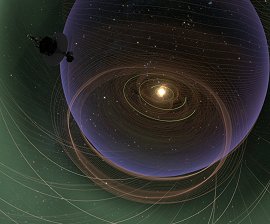
Their calculations indicated that a companion object was not only capable of creating these anomalous orbits, but was theoretically a better fit than the action of a passing star in the distant past. Here's a section of the conclusion Gomes et al wrote in their scientific paper:
"We have demonstrated that a distant planetary-mass solar companion (i.e., a planet orbiting within the inner Oort cloud) would be capable of raising the perihelia of scattered disk objects and placing them on orbits similar to those of Sedna and 2000 CR105. The perihelia of the SDO's are raised by the Kozai mechanism, so the orbit of such a hypothetical companion would in principle need to be substantially inclined to that of the orbit of the scattered disk object that was produced by perturbations of the known planets in order for the type of perturbations that we are discussing to operate efficiently.
"Note, however, that a very eccentric
Earth-mass companion with small perihelion (60 AU in the example that we
studied) and low inclination could also produce low inclination Sedna-like
orbits. The required minimum
companion mass would be only about Neptune's mass if it orbited with semi-minor
axis at 2000 AU, but would need to be a Jupiter mass at 5000 AU and 8 Jupiter
masses at 10,000 AU.
"A significant advantage of the solar companion model is that it naturally
produces the very massive inner Oort cloud that is suggested by observations to
date. A brown dwarf's planetesimals captured by the Sun can amount to a large
mass, but the inclination distribution could favor any arbitrary initial plane
(including retrograde)." (2)
Personally, I favour a sub-brown dwarf object located in the gap between the Kuiper Belt (which extends from Neptune out to about 50AU) and the Inner Oort Cloud (from about 2000AU outwards). The scientists indicate that an object at these sort of distance would need to be about as massive as Neptune, as a minimum. That still allows for an eccentric sub-brown dwarf within these parameters. Such an object would have 'swept out' the area of space between the Belt and the Cloud.
Interestingly, NASA recently put forward the idea that this same 'space' is currently occupied by part of an interstellar gas cloud, which they have given the unusual moniker 'Fluff' (3). This proposition is a response to the finding by the Voyager probes that the Heliopause (the sheath-like border between the solar wind and interstellar space ~75AU away) is misshapen. It goes without saying (but I will say it anyway) that a companion object that has created the Kuiper Belt Object anomalies is also quite capable of manifesting a huge magnetic field, and of denting the Heliopause.
Written by Andy Lloyd, 7th January 2010
References:
1)
with thanks to David S
http://en.wikipedia.org/wiki/90377_Sedna,
2) Rodney S. Gomes, John Matese & Jack Lissauer "A Distant Planetary-Mass Solar Companion May Have Produced Distant Detached Objects", Icarus, 184(2): 589-601, October 2006
3) Tony Phillips, NASA "Voyager makes and Interstellar Discovery" 23 Dec 2009, with thanks to Lee and Ivan - article no longer available online
Scientists Fret about Contact
This week a two-day conference is being held at the Royal Society in London, titled, 'The detection of extraterrestrial life and the consequences for science and society.' Professor Simon Conway Morris, a Cambridge University evolutionary biologist, will be talking at the Royal Society on 'Predicting what extraterrestrial life will be like – and preparing for the worst."
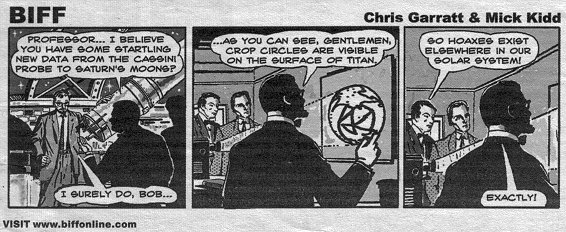
I heard about this conference on BBC radio this morning. Here's the Today
programme's piece about it. You'll need to move through to 1hr:24min into
it (about halfway through the 3 hour programme):
http://www.bbc.co.uk/iplayer/episode/b00q2nhg/Today_25_01_2010/
It's absolutely true that the debate about ET life in the scientific community
has changed in the last decade. Not only the discovery of so many planets (and
their frequency of discovery around target stars) but also the propensity for
life to be found in the most unlikely places on Earth (extremeophiles). Clearly,
life can find a way given the right conditions - and the right conditions seem
common throughout our corner of the galaxy, at least.
Will the aliens be friendly? Well, we certainly aren't, and nature is a
cut-throat place. There's every reason to suspect that nature works in the same
way on other planets, given the tenets of evolution through natural selection.
If trying to second guess alien visitors we should ask ourselves what we
would do if we discovered a planet nearby full of rich resources, and ripe for
the taking.
Such considerations are at the heart of my fictional writing. My new novel, "The
Followers of Horus", explores the nature of the Anunnaki, and how
their particular style of management, as it were, would impact upon an
unsuspecting modern humanity. I, for one, don't imagine them to be fun to be
around. It stands to reason that a species more advanced than us, and more
evolved than us, would have developed a greater social complexity than us, and
so be all the more damned difficult to deal with.
"Scientists searching for alien life should get governments and the UN involved lest we unwittingly contact hostile extraterrestrials, a British astronomer has warned. Mr Marek Kukula, public astronomer at the Royal Observatory in Greenwich, said "We might like to assume that if there is intelligent life out there it is wise and benevolent, but of course we have no evidence for this. Given the consequences of contact may not be what we initially hoped for, then we need governments and the UN to get involved in any discussions"." (1)
It seems that the likelihood of finding, and being found by, alien life is increasing rapidly. Upon making contact, we would have to get our collective heads around these concerns pretty fast.
Written by Andy Lloyd, 25th January 2010
Reference: "Aliens might not be friendly, warns astronomers" 24 Jan 2010,
with thanks to Jadran
Cool Brown Dwarf is both red and blue!
Perhaps the coolest brown dwarf yet! At about 200 degrees Celsius, the new T-dwarf SDSS 1416+13B is the binary companion of a larger brown dwarf star.
"An international team, led by British astronomers using the United Kingdom Infrared Telescope (UKIRT) in Hawaii, has discovered what may be the coolest sub-stellar body ever found outside our own solar system. This object is technically known as a brown dwarf, but what has excited astronomers is its very peculiar colors, which actually make it appear either very blue or very red, depending on which part of the spectrum is used to look at it."
It's only detectable in infra-red light, and astronomers have been studying it using different infra-red telescopes.
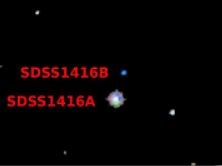
Image Credit: University of Hawaii
What's odd is that depending upon which set of wavelengths are used to view it (Using either UKIRT or Spitzer), the quixotic object is either surprisingly red, or surprisingly blue.
"The fact that it is a binary companion to a warmer brown dwarf that also has an unusual spectrum is helping us to fill in some some gaps in our understanding", says Dr. Ben Burningham of the University of Hertfordshire. "It seems likely that both brown dwarfs are somewhat poor in heavy elements. This would be consistent with the pair being old, which in turn implies a high gravity for both dwarfs, which can further enhance the unusual colors seen for both dwarfs."
Old, cool brown dwarfs are in my Dark Star territory, so this object could teach
us a lot about a potential Nemesis object orbiting our own sun at a great
distance. Already, it's proving
puzzling!
Written by Andy Lloyd, 30th January 2010
Reference:
University of Hawaii Press Release "Astronomers Discover Cool Stars in Nearby Space" 29 January 2010, with thanks to David
Dark Star discovery within 3 years?
It seems that we will have to wait until 2012-13 before we can get an answer to the question of whether a multiple-Jupiter-mass planet lurks out there unseen. WISE, the powerful new infra-red survey, is hard at work hunting down brown dwarfs, and any Dark Star remaining to be discovered in the solar system should get spotted by this device.
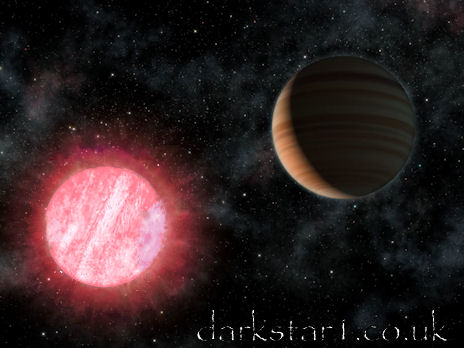
But it won't be until 2012 or 2013 before we know for sure. That's longer than I thought it would take, but makes sense given the fact that such an object would be very slow moving among the field of stars, and needs to be pinpointed by its relative motion in the sky, as well as by its bright infra-red signature.
"“The great thing about WISE, as was
also true of 2MASS, is that it's an all-sky survey,” said Kirkpatrick. “There
will be some regions such as the Galactic Plane where the observations are less
sensitive or fields more crowded, but we'll search those areas too. So we're not
preferentially targeting certain directions.”
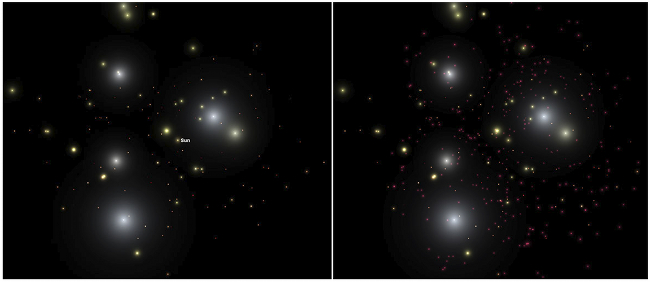
Our local neighbourhood brown dwarf population is expected to show up in the WISE data
"We may not have an answer to the Nemesis question until mid-2013. WISE needs to
scan the sky twice in order to generate the time-lapsed images astronomers use
to detect objects in the outer solar system. The change in location of an object
between the time of the first scan and the second tells astronomers about the
object’s location and orbit. “I don't suspect we'll have completed the
search for candidate objects until mid-2012, and then we may need up to a year
of time to complete telescopic follow-up of those objects,” said Kirkpatrick."
For many reasons, I suspect that the Dark Star lies near to
the galactic plane, in the constellation of Sagittarius. This is one of
the most difficult constellations to pinpoint solar system objects among the
intense fields of background stars. It would generally be avoided by
astronomers hunting for, say, Kuiper Belt objects. It sounds like the WISE
team plan to take that constellation on, just like the rest. But it won't
be easy!
Written by Andy Lloyd, 13th March 2010
References:
1) Leslie Mullen "Getting WISE about Nemesis" 11 March 2010, with thanks to David
2) This led to the following article in 'The Sun', which has a UK circulation of 7 million: Paul Sutherland "Earth under Attack from Death Star" 12 March 2010, thanks to Mart - article no longer available online
3) And this then propagated around the Globe, in the great spirit of churnalism: thanks to Rob (beware the pop-up adds on this one)
Comets, and the End of the Ice Age
The dates of the return of Nibiru have been a controversial point for decades. I have always favoured the model originally put forward by Zecharia Sitchin - that the visit by Anu in 3760 BCE was one definitive marker (it kick-started ancient calendars in the Levant region). Another very likely marker was the catastrophe that brought about the collapse of the last glacial period, thought to be about 13,000 years ago. This may have been the Biblical Flood, a story that is featured in a huge number of the world's comparative mythologies, and may have come down to historical writings through oral transmission across millennia.
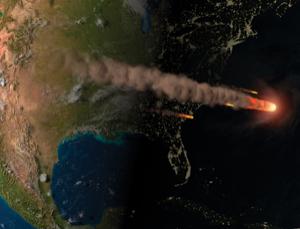
Ice ages come and go, and the previous Ice Epoch lasting for some 4 million years was punctuated by interglacial periods. We may, or may not, be in such a period now. It's difficult to determine whether that marker around 11,000BCE was really the end of an Ice Epoch, or just the beginning of the current warm period attributable to various planetary and astronomical cycles.
An eminent astronomer, Professor Bill Napier, thinks that there was a multiple comet strike on Earth at that time, which brought about a catastrophic period of cooling:
"The cooling, by as much as 8°C, interrupted the warming which was occurring at the end of the last ice age and caused glaciers to readvance. Evidence has been found that this catastrophic change was associated with some extraordinary extraterrestrial event. The boundary is marked by the occurrence of a "black mat" layer a few centimetres thick found at many sites throughout the United States containing high levels of soot indicative of continental-scale wildfires, as well as microscopic hexagonal diamonds (nanodiamonds) which are produced by shocks and are only found in meteorites or impact craters.
"These findings led to the suggestion that the catastrophic changes of that time were caused by the impact of an asteroid or comet 4 km across on the Laurentide ice sheet, which at that time covered what would become Canada and the northern part of the United States. The cooling lasted over a thousand years, and its onset coincides with the rapid extinction of 35 genera of North American mammals, as well as the disruption of the Palaeoindian culture."
He argues that a large comet, which had entered the planetary zone of the solar system some 20-30,000 years ago, has been breaking up ever since, and has left a debris field of rocky fragments in its wake. In this model, the debris field crossed the path of the Earth's trajectory, and the North American continent was hit by a deadly shower. There are no craters to mark the event because the comets struck the glacial sheet which covered much of the continent at that time.
Could such a debris field be attributable to a more transient event - like the movement of Nibiru through the planetary solar system? It seems likely to me that any sizeable Planet X body would come with its own retinue. Given that I believe a sub-brown dwarf lurks out there, moving along an elongated, elliptical trajectory, then there is scope for a whole planetary system to accompany it! A swarm of comets seems a reasonable proposition as the Sun's planetary system plays host to the Dark Star's at perihelion. Such an event would not occur during each transit - it would simply depend upon the positioning of the Earth in the solar system, and how that relates to the belts of Dark Star comets as they move through.
Dates? Well, if we take Sitchin's 3600 year orbit at face value and work backwards from 3760BCE, then we get 7360BCE and then 10,960BCE. The rough date of Napier's catastrophe is cited as 10,890BCE. There are a number of possible scenarios for the Dark Star's orbit, but this date in particular is a very good candidate for a previous return.
Written by Andy Lloyd, 6th April 2010
Reference:
W.M. Napier "Palaeolithic extinctions and the Taurid Complex" 3 May 2010
https://arxiv.org/pdf/1003.0744.pdf
ScienceDaily "Was a giant comet responsible for a North American catastrophe in 11,000 BC?" 1 April 2010, with thanks to John K
Wide Binary Brown Dwarfs Reveal Their Secrets
Dark Star-like objects are starting to be discovered, in parts of the Milky Way thick with brown dwarfs. One of these newly discovered companion objects, of between 5 - 10 Jupiter masses, lies in orbit around a brown dwarf at an equivalent distance to our Sun's gas giants. Given that the parent star is only a brown dwarf star itself, this is a considerable distance - well beyond the parent's initial proto-planetary disk.
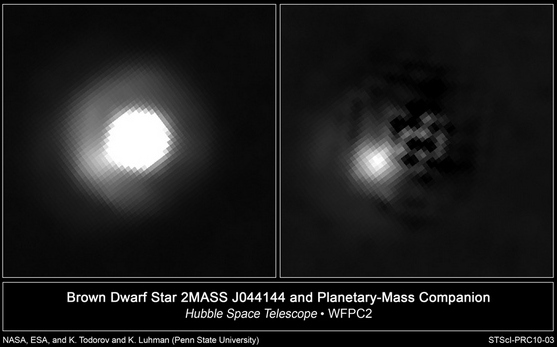
Hubble Space Telescope image of the young brown
dwarf 2M J044144
Image credit: NASA, ESA, and Z. Levay (STScI)
The companion sub-brown dwarf has also formed in less than one million years - a staggeringly short period of time. The implications of this are huge, at least for the theory on this website. It means that these large companion objects can form at a very wide distance from their parents, using unexpected planet-forming mechanisms.
"Their investigations of the nature of this mysterious object and its companion brown dwarf have revealed a new mechanism that Nature can use to make orbiting planetary-mass objects. "Our research demonstrates that nature can make planetary-mass bodies through the same mechanism that builds stars -- and that the mystery object has both planet-like and star-like characteristics," said [Kevin] Luhman [of Penn State University].
""The most interesting implication of this result is that it shows that the process that makes binary stars extends all the way down to planetary masses -- so it appears that nature is able to make planetary-mass companions through two very different mechanisms.""
I've often discussed the likelihood that a Dark Star in our own solar system would have formed as part of a cluster in the very early days of the Sun's own birth.
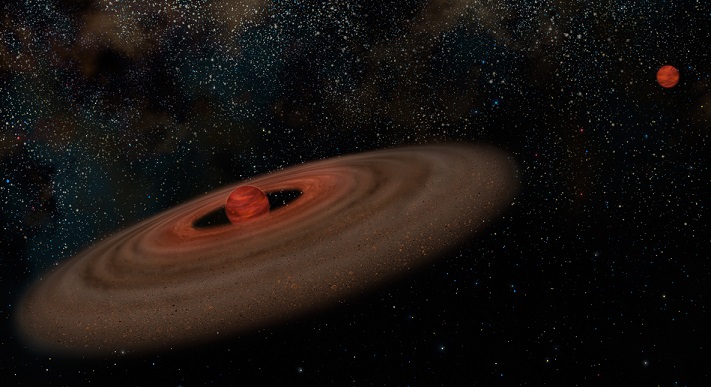
Image credit: Gemini Observatory
In such a scenario, we simply don't need to consider how a part of the Sun's protoplanetary disk needs to extend out to comet distances to accrete enough matter for a gas giant/sub-brown dwarf to form. A speckled cluster of adjacent star-forming material could create a wide-binary sub-brown dwarf at a great distance. Possibly more than one! This latest discovery adds weight to this concept, and opens up the potential for the discovery of a Dark Star object orbiting our own sun.
Andy Lloyd, 7th April 2010
References:
Ray Villard & Barbara Kennedy "Mysterious Planet-like Object Challenges Simple Definition, Reveals Its Surprising Identity", 6 April 2010, with thanks to Monika and David
Closing in on Neighbouring Dark Stars
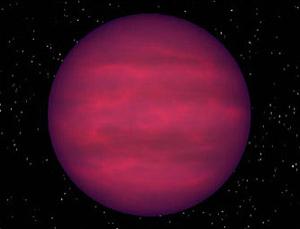
A very cool discovery has been made by astronomers at University of Hertfordshire in England. The coolest brown dwarf yet has been found about 10 light years away. This Dark Star might be a tiny brown dwarf, or possibly even smaller - a sub-brown dwarf, similar in size to the proposed Planet X object I write about. Called UGPS 0722-05, its surface temperature is between 130 - 230 centigrade.
"A dim object less than 10 light years from Earth appears to be the closest brown dwarf yet found. The "star" is so cold that any residents on an orbiting planet would see a dark sun in their starry "daytime" sky. The discovery suggests that brown dwarfs are common and that the objects could exist even closer to Earth." (1)
Tantalisingly, I describe such a dramatic sky in my new book 'The Followers of Horus', which is due for release soon. Remarkably, this new neighbouring 'star' was found in an infra-red search covering just a few percent of the total sky. The implication of this is clear - there may be a great many of these objects out there, floating around in the dark among the Sun's near neighbours.
"The object's feeble nature explains why it has only now been spotted, despite its proximity. It was found after surveying only a few per cent of the sky, which implies that many more brown dwarfs are lurking nearby undetected." (1)
Just twenty years ago, many astronomers would have dismissed the prospect of discovering failed stars like these. These kinds of objects did not sit well with the prevalent theories of star and planet formation. But here we are, finding sub-brown dwarfs in our celestial backyard. As common as muck.
Written by Andy Lloyd 19th April 2010
References:
1) Ken Crosswell, "'Dark sun' is one of our nearest neighbours", 9 April 2010, with thanks to David, Ivan and John
2) Philip W. Lucas et al "The discovery of a very cool, very nearby brown dwarf in the Galactic plane" Monthly Notices of the Royal Astronomical Society: Letters, 408(1): L56–L60, October 2010
https://arxiv.org/pdf/1004.0317.pdf
New paper by Drs Matese and Whitmire
Dr John Matese and Daniel Whitmire, of LaFayette University in Louisiana, first put forward evidence for a multiple Jupiter mass companion in 1999. Based on statistical analysis of the direction of arrival of of long-distance comets, they believe that a massive unseen companion lies among the outer Oort cloud of comets. It has a hand in comet activity, creating an uneven inward flow from the outer solar system. They have been continuing their research ever since, and have just submitted the following new paper, further building on their case for a 'Dark Star'. They even go so far as to describe the proposed orbit, which is retrograde. Here's their published abstract:
"We present an updated dynamical and statistical analysis of outer Oort cloud cometary evidence suggesting the sun has a wide-binary Jovian mass companion. The results support a conjecture that there exists a companion of mass ~ 1-4 M_Jup orbiting in the innermost region of the outer Oort cloud. Our most restrictive prediction is that the orientation angles of the orbit normal in galactic coordinates are centered on the galactic longitude of the ascending node Omega = 319 degree and the galactic inclination i = 103 degree (or the opposite direction) with an uncertainty in the normal direction subtending ~ 2% of the sky.
"A Bayesian statistical analysis suggests that the probability of the companion hypothesis is comparable to or greater than the probability of the null hypothesis of a statistical fluke. Such a companion could also have produced the detached Kuiper Belt object Sedna. The putative companion could be easily detected by the recently launched Wide-field Infrared Survey Explorer (WISE)."
Written by Andy Lloyd, 27th April 2010
Reference
John J. Matese, Daniel P. Whitmire "Persistent Evidence of a Jovian Mass Solar Companion in the Oort Cloud", Icarus, 211(2):, , Pages 926-938, February 2011, with thanks to John Matese
Does the water ice discovered on an asteroid belong to Tiamat?
Here's something for Sitchin fans. Water ice, as well as organic material, has been discovered coating the surface of an asteroid located between Mars and Jupiter. This is particularly relevant to Sitchinites because of the possibility that the asteroid belt constitutes the remains of the watery, primordial world 'Tiamat', that was broken up by one of the early passages of Nibiru. The Earth was the largest of the remaining fragments, knocked into a new orbit closer to the Sun, the ancient Mesopotamian myths suggest.
Does the water ice on 24 Themis correlate isotopically with water on Earth (see my 2005 book, 'The Dark Star')? Perhaps we'll find out soon enough, if NASA pays the asteroid belt a visit. Here's a short extract, as well as the reference to today's news:
"The discovery of abundant ice on 24 Themis may mean that water is much more common in the Main Belt of asteroids than previously thought. Since Themis is part of an asteroid "family" that was formed from a large impact and the subsequent fragmentation of a larger body long ago, this scenario means the parent body also had ice and has deep implications for how our solar system formed."
Written by Andy Lloyd, 29th April 2010
Reference:
Nancy Atkinson "Possible Destination? Researchers Find Water Ice and Organics on Asteroid" 28 April 2010
2010 "Dark Star" Crop Circle
This enigmatic crop circle was found this month in a field of oil seed rape near Old Sarum, which is near Salisbury in south England.
There is clear Dark Star symbolism in this pictogram - it depicts a dual solar system with two suns: the Sun, and the Dark Star with its own seven moons/planets. More information about the crop circle is available from the Daily Mail website:
Written by Andy Lloyd, 9th May2010
Reference:
Jessica Satherley "Summer starts today and, bang on cue, the first crop circle of 2010 pops up" 7 May 2010, with thanks to Jeffrey
Planets in Different Planes
One of the potential stumbling blocks to the Dark Star Theory, and the concept of a Planet X body in general, has been something called the Kozai effect. Orbiting bodies inclined to a system plane exchange their inclination for greater eccentricity over time. This has been confirmed in practice for satellites, moons, etc. This places restrictions on orbits within a system, and has been used by sceptics as an argument against a Planet X body inclined at, say, 30 degrees (as claimed by Sitchin for the hypothetical planet Nibiru).
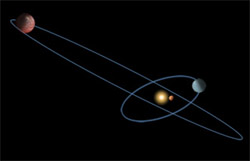
(Credit: NASA, ESA, and A. Feild (STScI))
More broadly, planets within a system that are inclined at high angles to each other are considered to be much less stable than a system where all the planets revolve around their parent star within the same plane. From a common sense point of view, this seems to be a truism. Furthermore, our current models of planet formation involve proto-planetary disks, which are vast and relatively flat clouds of gas revolving around young stars which eventually condense down into planets. Again, we are left with the flat system where planets revolve within a plane.
So, it is something of a surprise (and, for me, a big relief!) that a team of astronomers led by Barbara McArthur of the University of Texas, have discovered a extra-solar planetary system that is not remotely flat. The planets appear to orbit at inclinations of 30 degrees to each other in the star system Upsilon Andromedae A, which is located about 44 light years away. It is part of a binary star system, and the planets in question are Jupiter-sized. The star system has been around for a while, and one would have thought that these inclined orbits would have been subject to the Kozai effect over time. Apparently not.
That's not to say that the effect is not useful in our understanding of orbital systems. But, as with nature in general, complexity and diversity have a way of surprising us. Inclined planetary systems clearly exist in practice. Therefore, a Planet X body (even Jupiter-sized!) sharply inclined to the Sun's planetary plane could indeed prove to be stable over a long period of time.
Andy Lloyd, 25th May 2010
Reference:
NASA "Out of Whack Planetary System Offers Clues to a Disturbed Past", 24 May 2010, with thanks to David
A New Name for Nemesis?
As WISE continues its search for dim celestial objects in the infra-red spectrum, astronomers have turned their thoughts to what they might call a brown dwarf orbiting the Sun. For decades the moniker attached to such a body has been Nemesis. However, that name brings with it connotations of destruction and extinction-level events. As such, a new name has been proposed:
"[Davy] Kirkpatrick says that it's possible that WISE could find an icy, Neptune-sized or bigger object in the far reaches of our solar system - thousands of times farther from the sun than Earth. There is some speculation amongst scientists that such a cool body, if it exists, could be a brown dwarf companion to our sun. This hypothetical object has been nicknamed "Nemesis."
"We are now calling the hypothetical brown dwarf Tyche instead, after the benevolent counterpart to Nemesis," said Kirkpatrick. "Although there is only limited evidence to suggest a large body in a wide, stable orbit around the sun, WISE should be able to find it, or rule it out altogether"." (1)
I like the name Tyche - it suggests a small companion, much as a brown dwarf would be.
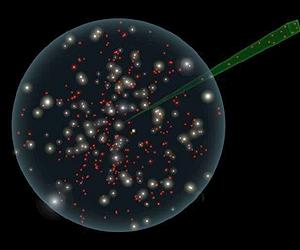
Image Credit: AMNH/UCB/NASA/JPL-Caltech
Based upon the limited number of brown dwarf discoveries made so far, astrophysicists are now estimating that there may well be about 100 brown dwarfs within 25 light years yet to be discovered. It has been a long-standing belief that there is a 50:50 chance that one or more brown dwarfs may lie within 4 light years of us - making such objects potentially our nearest stellar neighbours.
1) Space Daily Staff Writers "The Coolest Stars Come Out Of The Dark" 25th June 2010, with thanks to Ann and Peter, and David
Cassini Data Points to Planet X/Nemesis
The Open Astronomy Journal has published what may be a very promising new paper by an Italian astronomer named Lorenzo Iorio. In his paper, he sets out data sent back to Earth from the Cassini probe that seems to imply the presence of a massive, undiscovered companion to the Sun. The latest data from Cassini, measuring Saturn's orbit around the Sun, indicates that there is a precession effect in the gas giant's orbit. It is thought that this recognised effect might be attributable to the existence of a substantial Planet X body, whose location and size are open to debate (i.e. the larger the companion object, the further it is away from the Sun).
In the paper's abstract, various distances are proposed. For a rocky, terrestrial Planet X, the object would be located well beyond the Kuiper Belt. For a gas giant/ small brown dwarf the distances involved increase to the inner edge of the Oort Cloud of comets. This range sits well with my proposed Dark Star parameters.
Even more striking is the contention that this body might lie in the direction of the Galactic Core, which, once again, reflects my own proposals in my books:
"If X was directed towards a specific direction, i.e. that of the Galactic Center, it would mimick the action of a recently proposed form of the External Field Effect (EFE) in the framework of the MOdified Newtonian Dynamics (MOND)". (1)
This is an exciting development, and perhaps indicates how these ideas are gaining ground within the academic astronomical community.
Written by Andy Lloyd, 1st July 2010
Reference:
Lorenzo Iorio "The Perihelion Precession of Saturn, Planet X/Nemesis and MOND" The Open Astronomy Journal, 3: 1-6. 2010, with thanks to Mattia
Nemesis and Extinction Cycles
A new scientific paper looking at the possible existence of Nemesis has come to an unusual conclusion - the extinction event periodicity of 27 million years is likely true, but that the set of intervals between events is too precise to be due to a Dark Star. It is argued that the effect of passing stars etc. would affect the Dark Star's orbit over time, leading to a more chaotic series of intervals between extinction events on Earth over the last half a billion years (1).
"The cyclical extinctions do make a solid pattern, say Adrian Melott of the University of Kansas and Richard Bambach of Smithsonian Institution Museum of Natural History, whose paper is available through arXiv.org (2). The two have gone back in the record to 500 million years ago, further than any other researchers, and have confirmed the 27 million year cycle at a 99 percent confidence.
"The problem, Nemesis fans, is that the cycle is too precise, the researchers say. If these extinctions result from a dance between our sun and Nemesis, the researchers note, the period of these mass extinctions would change as other stars buffeted the pair and changed the courses of Nemesis’s orbit around the sun. But the data indicates that the extinctions occur every 27 million years, as regular as clockwork.
"Some scientists say that the sharply-defined periodicity isn’t enough to rule out Nemesis. Richard Muller, an author of the original Nemesis paper, told Wired.com that there is still hope for a dark star." (1)
Which begs the question - if an extinction pattern has been proven, and works like clockwork over millions of years, then what else could be the cause? The solution must have an astronomical dimension, surely? It seems to me that this paper merely enhances the chances that a Dark Star is lurking out there.
Written by Andy Lloyd, 14th July 2010
References:
1) Joseph Calamia "Study: A Death Star Named Nemesis Isn’t to Blame for Mass Extinctions" 13 July 2010, with thanks to David
2) Melott A. & Bambach R. "Nemesis Reconsidered", Monthly Notices of the Royal Astronomical Society: Letters, 407: L99-L102, July 2010
A Planet with a Tail
The discovery of a planet shedding its atmosphere like a comet is not a particular surprise for astronomers. Ever since the so-called 'Hot Jupiters' were found - gas giants orbiting their stars in just a few days - such an effect has been acknowledged as highly likely. Now it's been confirmed with the planet HD 209458b.
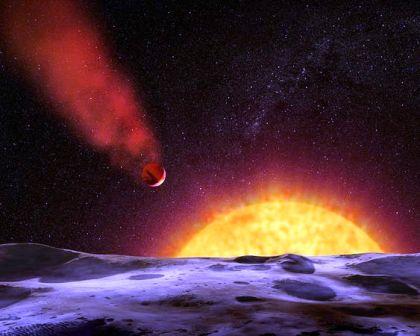
Image credit G. Bacon, NASA/ESA
Although this is not a 'Dark Star' scenario, the comet-planet is one of the essentially ingredients of the Nibiru hypothesis: A planet with a comet-like orbit periodically enters the solar system, shedding volatile gases to the solar wind and creating a dramatic, red tail. Nibiru never gets this close to the Sun, and Nibiru needs a tenable atmosphere even in the frigid vacuum of the outer solar system, so direct comparisons cannot be made. But this image supplied of a gas giant shedding its volatile atmosphere lends itself beautifully to a Dark Star perihelion passage.
Written by Andy Lloyd, 17th July 2010
References:
1) NASA "NASA Finds Super-Hot Planet with Unique Comet-Like Tail" 15 July 2010
2) National geographic "Planet found with a comet-like tail" 17 July 2010 with thanks to John
nationalgeographic.com article
More Dark Star Theory Confirmation!
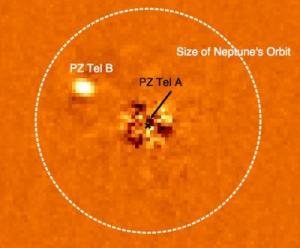
Those were the words of my editor Lee Covino when he recently came across the following item of astronomy news. Like many of my helpful readers, he kindly sent this through to me. It's news of a brown dwarf star found orbiting a relatively nearby Sun-like star. The system, PZ Tel A (& now B), is quite young. Remarkably, the brown dwarf companion follows an eccentric orbit, and is currently located at an equivalent distance to the planet Uranus from the Sun (1).
This shows that much of what I have written in the past about the feasibility of unusual brown dwarf binaries has been confirmed. Brown dwarfs with eccentric orbits can, like comets, move close to the parent stars during perihelion. This opens up the possibility that a Dark Star in our own system could have done the same. Such a concept no longer seems far-fetched at all.
Astronomers are interested to learn whether other planets have been able to form in this system. On the face of it, the brown dwarf would seem to make that job very difficult. But, as many of my long-time readers would note with a wry smile, such early scientific proclamations about brown dwarfs have been proven wrong before!
Written by Andy Lloyd, 30th July 2010
Reference:
1) "Brown dwarf orbiting sun-like star discovered" 30th July 2010, with thanks to Lee, Brian, Monika and Jeffrey
Cometary composition infers a Dark Star companion
One of my editors, Lee, has been keeping an eye on the comet composition controversy. Some of the scant data that has been made available indicates that the origin of outer solar system comets involves a birthplace much hotter than current theory allows. The geological composition requires temperatures in the thousands of degrees - and this is not possible in the outer solar system, even during primordial times when there was a proto-planetary disk. We think that this is due to the existence of an as-yet unconfirmed binary companion in the shape of a sub-brown dwarf.
Anyway, Lee sent me an on-line excerpt from the book 'The Electric Universe', by Wallace Thornhill and David Talbott, which is no doubt already familiar material for many readers.
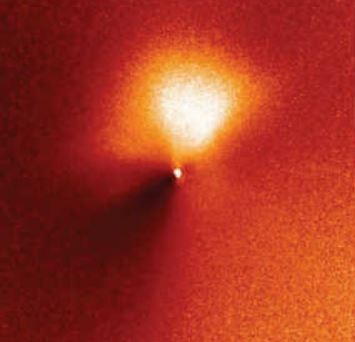
Image Credit: NASA/HST
The relevant excerpt is entitled 'Comet Material Born in Fire', which can be found about half-way down the page in the Page 98 information panel. It makes for some enlightening reading with respect to the possible existence of a Dark Star out there:
"NASA’s celebrated Stardust mission returned to Earth the first samples ever of comet dust. On January 2, 2004, the Stardust craft swept past Comet Wild 2, trapping particles as they struck 'aerogel' in a 100- pound capsule. The capsule parachuted to a Utah desert on January 15, 2006. Shockingly, the particles contained minerals that can only be formed at temperatures of thousands of degrees. Mineral inclusions ranged from anorthite, which is made up of calcium, sodium, aluminum and silicate, to diopside, made of calcium magnesium and silicate.
How could this be? We have been assured that comets are the leftovers of a cold 'nebular cloud' that formed the solar system. This hypothesis has become an article of faith. Indeed, the implication of a fiery cometary past was so unexpected that an early sample of dust was thought to be contamination from the spacecraft." (1)
Written by Andy Lloyd, 30th July 2010
Reference:
1) Wallace Thornhill and David Talbott "The Electric Universe: Electric Comets Part 3" Mikamar Publishing
The Astrophysics of an Incoming Brown Dwarf
With two years to go before the end of the Mayan Age, speculation about the arrival of a Planet X body remains high, despite the lack of a sighting by either professional or amateur astronomers. Two years may seem a lot, but in an astronomical sense it is a minute period of time. Certainly, a substantial planet in an elliptical orbit would have to be moving towards us at an extraordinary speed to cover the distance from a remote point, where it has successfully evaded detection, to the inner solar system in that time.
Indeed, the velocities required would mean that an incoming Planet X object would be travelling so fast so as to achieve escape velocity from the solar system. Don't believe me? Well, an astrophysicist has been doing some calculations for an incoming stellar-sized object. Bear in mind that he assumes a massive brown dwarf at 80 Jupiter masses, rather than a Jupiter-like sub-brown dwarf of, say, 5 Jupiter masses. But, even so, his calculations for its incoming speed is eye-watering to say the least.
"We analytically and numerically investigate the possibility that a still undiscovered body X, moving along an unbound hyperbolic path from outside the solar system, may penetrate its inner regions in the next few years posing a threat to the Earth. By conservatively using as initial position the lower bounds on the present-day distance dX of X dynamically inferred from the gravitational perturbations induced by it on the orbital motions of the planets of the solar system, both the analyses show that, in order to reach the Earth's orbit in the next 2 yr, X should move at a highly unrealistic speed v, whatever its mass MX is."
An incoming brown dwarf star would need to be achieving speeds up to 10% of the speed of light. It's my opinion, and has been all along, that there is no incoming Planet X object. It remains a possibility (and I argue a strong possibility) that a sub-brown dwarf lurks well beyond the Kuiper Belt, and nearer the distant comet clouds circling the Sun. But it offers no direct threat to our planet. This latest paper provides further hard evidence to be sceptical about a 2012/2013 Planet X 'event'.
Written by Andy Lloyd, 30th September 2010
Reference:
Lorenzo Iorio "Is it plausible to expect a close encounter of the Earth with a yet undiscovered astronomical object in the next few years?" Submitted 7 September 2010, with thanks to Mattia
Habitable World Prediction Comes True
My fictional work is a vehicle to put forward some new insights and ideas. In "The Followers of Horus" I have outlined how a world orbiting a Dark Star could provide an habitable environment for life. Scientists discuss 'The Goldilocks Zone' - the rough distance from a given star where liquid water on a planet's surface could support life. The smaller the star, the nearer the planet must be to the star to be within this habitable zone.
The Sun is technically a 'yellow dwarf', and lies on at the high end of the dwarf star spectrum. The next down is a red dwarf, and a planet in its Goldilocks Zone has a much smaller orbit than Earth. Brown dwarfs have closer zones still, and sub-brown dwarfs, like the Dark Star I describe, have very close Goldilocks Zones - almost like moons.
The closer planets get to their parent stars, the more likely they will be 'tidally locked', like our Moon is to the Earth. This means that the planet rotates on its axis over the same time period as it rotates around the dwarf star. This is known as 'synchronous rotation'. The result of this is that one side of the planet will face the dwarf star at all times.
That's why I predicted in "The Followers of Horus" that a habitable planet circling the Dark Star would be tidally locked. Funny, then, that an exciting new discovery in the extensive Gliese 581 planetary system should involve a habitable world with synchronous rotation!
Gliese 581g bears the same hallmark as my fictional account of the Anunnaki homeworld of Nibiru, as I've described in "The Followers of Horus". For further details, including an extract from the book, follow this link:
Solar Storms and 2012
In a brand new article, I discuss the threat of immense solar flares, like the one that occurred in 1859, and how the Dark Star's presence in the solar system may have created a Grand Solar Cycle that could produce 'the big one'. The effects upon our modern world would be truly catastrophic:
The British Museum and Nin Puabi
A curator at the British Museum has replied to a query about the remains of Nin Puabi, which were brought to the attention of the late Zecharia Sitchin's readers this year. She says that there are only fragments of the queen's skull remaining, and that they are not actually located at the British Museum. You can read the full correspondence here:
'There Were Giants Upon the Earth'
New Human Species Identified
First we had Neanderthals in Europe and the Middle
East, then the Hobbit (Homo
Floresiensis) in Indonesia - now there's a new species of human to add
to the growing pile. They lived in Asia and have been named the 'Denisovans':
"Scientists say an entirely separate type of human
identified from bones in Siberia co-existed and interbred with our own species.
The ancient humans have been dubbed Denisovans after the caves in Siberia where
their remains were found. There is also evidence that this group was widespread
in Eurasia.
A study in Nature journal shows that Denisovans co-existed with Neanderthals and
interbred with our species - perhaps around 50,000 years ago. An international
group of researchers sequenced a complete genome from one of the ancient
hominins (human-like creatures), based on nuclear DNA extracted from a finger
bone." (1)
I wonder what Zecharia Sitchin would have made of it? The pre-history of
humanity is getting more complicated all the time.
Written by Andy Lloyd, 24th December 2010
Reference:
1) Pallab Ghosh "Ancient humans, dubbed 'Denisovans', interbred with us" 22nd December 2010
Take That and the Dark Star

I've talked about Robbie Williams before, and his well-known interest in Ufology. As you will know, he has re-joined pop band Take That and their new album is upon us. The first single is called 'The Flood', and has a highly enigmatic lyric. I can't reproduce the entire lyric, due to copyright reasons, but I think that the following line is particularly noteworthy for readers of this website:
"Here we come now on a dark star, seeing demons, not what we are."
The song's lyric is unusual, to say the least, and defies an easy explanation. What does it mean? A lone reference to the Dark Star might be innocent enough, but the inclusion of 'demons' makes this quite interesting to me.
Sumerologists believe that the ancient Mesopotamians considered the Anunnaki to be demons. Given that the Anunnaki are the denizens of the Dark Star system that I've written about extensively, then this might be a hidden reference to the Dark Star Theory in this popular song lyric. Furthermore, the title of the song itself -- The Flood -- is potentially another reference to the Dark Star. In Sitchin's discussion of the Flood, as described in early Mesopotamian myths, the Anunnaki play a pivotal role in events on Earth at that time, and Nibiru (the Dark Star) is the source of the catastrophic earth-changes that bring the Flood about. Lots of this lyric point to an understanding of Sitchin's version of our ancient history.
Normally, I would just consider this to be a bizarre coincidence - except that in this case Robbie Williams might well be introducing esoteric ideas into this song. He's clearly into this stuff!
Written by Andy Lloyd, 31st December 2010
Reference:
All articles written by Andy Lloyd, 2010, author of
